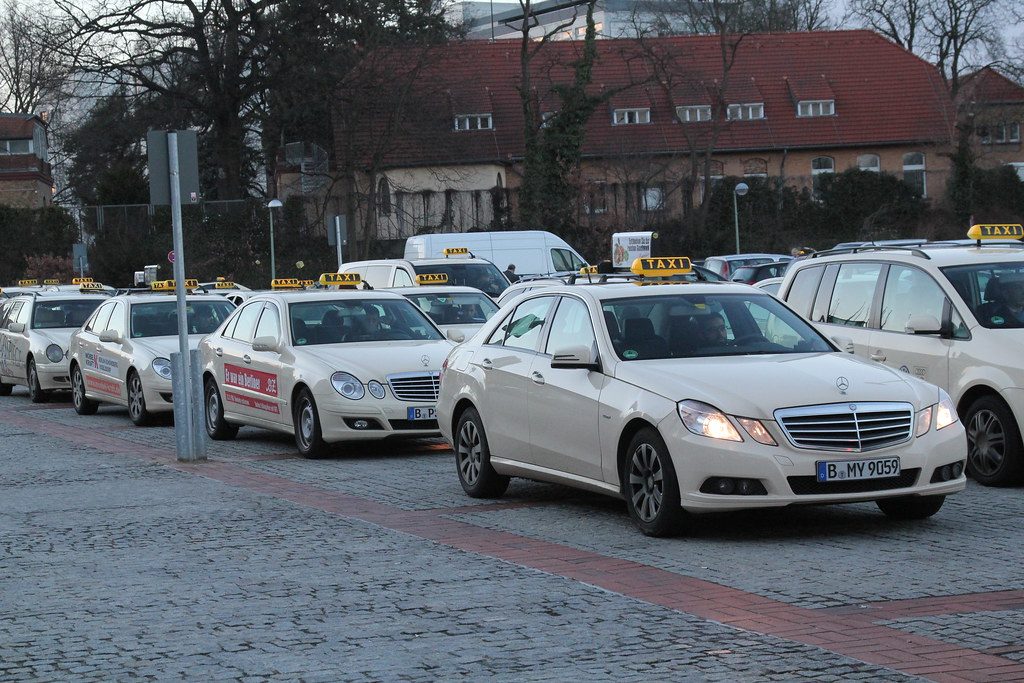
Tips for how to get around Berlin
Berlin has an extensive public transport system consisting of trains, trams, and buses. Transport routes can be found using mapping services, such as Google Maps.
Summary
- Buy tickets for trains, trams and buses through the BVG tickets app (external link). Simply open the app, and register on the ‘My BVG’ tab.
- ‘4 single-trip tickets’ are great for occasional travel
- A ‘Day ticket’ is suitable for up to 4 days and a ‘7 day ticket’ for between 5-7 days.
- An ‘Extension ticket’ can be added for trips to and from the Schönefeld Airport.
Tickets
Berlin Transport tickets allow you to travel anywhere in Berlin within two hours, but you may not use them for return trips.
An AB ticket covers the whole of Berlin, ABC tickets for areas outside Berlin (including the Schönefeld Airport), and ‘extension’ tickets that you can add to enable travel outside Berlin with a regular AB ticket.
Where and how to buy
You can buy a virtual ticket or a paper ticket.
Virtual or mobile tickets: Use the BVG tickets app (external link) to buy tickets if you have access to mobile internet. Install and open the app, register on the “My BVG” tab, set up payment, and you are ready to go.
Should the app request more info as a German resident when using credit card payment, you can enter the address of your accommodation, and it will allow you to complete the transaction.
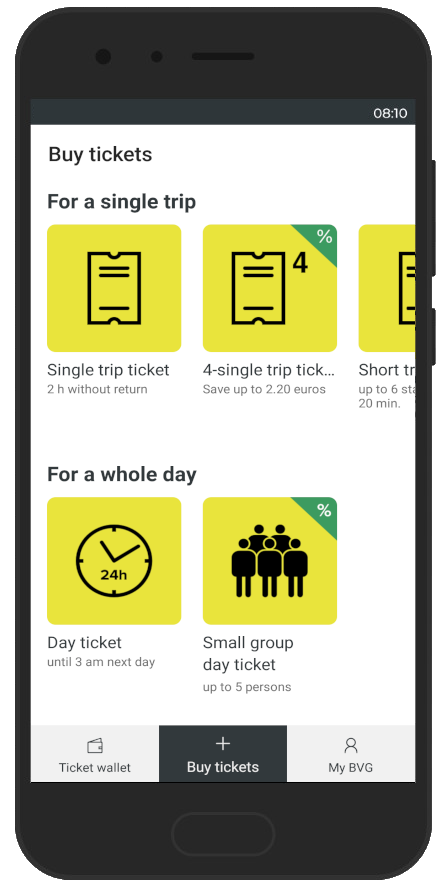
Paper tickets: Ticket machines at train stations only take small change, such as coins or 5 and 10-euro bills, or German bank cards. Ticket machines on trams and buses only accept small change, no cards. Be aware that machines may sometimes be broken, or there can be a line during busy periods.
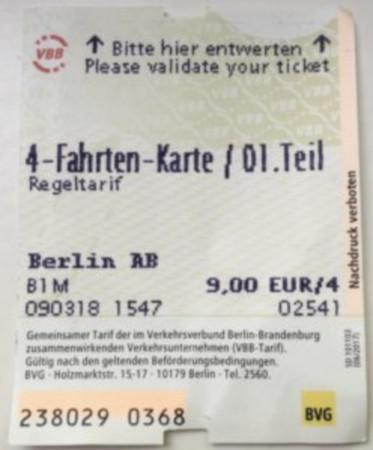
The BVG app and ticket machines are multilingual.
Which ticket to buy
The ticket that best suits your needs, and how much it costs, depends on how often you plan to use public transport and how long you stay in Berlin.
You can purchase single tickets, but it is often cheapest to buy a four-pack of tickets at once. If travelling more than twice in a day, then a day pass is cheaper (valid until 3:00am on the day after purchase).
There are also special tourist tickets called the Berlin Welcome card (external link) and Berlin City Tour card (external link), which can be used for entry to many tourist attractions, such as museums and the Berlin TV Tower. There are also ‘reduced’ tickets that refer to the reduction in price for those under the age of 15 (details below on tickets for children).
Ticket prices (as of 31 May 2019)
| Ticket type | AB zone price (Berlin only) | ABC zone price (includes Schönefeld airport) |
| Children under six | free | free |
| Short trip reduced (children) single * | €1.30 | n/a |
| Short trip single * | €1.70 | n/a |
| 4 reduced (children) short trips * | €4.40 | n/a |
| 4 short trip single * | €5.60 | n/a |
| Reduced single (children) | €1.70 | €2.50 |
| Single | €2.80 | €3.40 |
| 4 reduced (children) | €5.60 | €9.60 |
| 4 single trips | €9 | €13.20 |
| Day reduced (children) | €4.70 | €5.30 |
| Day | €7 | €13.20 |
| Small group day (up to 5 people) | €19.90 | €20.80 |
| 7 day | €30 | n/a |
| Berlin Welcome Card 48 hours | €19.90 | €22.90 |
| Berlin Welcome Card 72 hours | €28.90 | €30.90 |
| Berlin Welcome Card 72 hours + museum island | €45 | €47 |
| Berlin Welcome Card 4 days | €33.50 | €35.90 |
| Berlin Welcome Card 5 days | €36.90 | €41.50 |
| Berlin Welcome Card 6 days | €42.50 | €46.50 |
| Berlin City Tour Card 48 hours | €16.90 | €17.90 |
| Berlin City Tour Card 48 hours | €23.90 | €24.90 |
| Berlin City Tour Card 48 hours | €29.90 | €31.90 |
| Berlin City Tour Card 48 hours | €33.90 | €37.90 |
| Extension ticket (allows travel in C zone with AB ticket) | €1.60 | included |
* Only valid for 20 min and for up to three train stations or six bus stops
How to use transport tickets
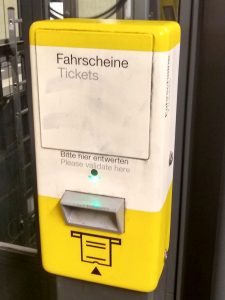
Virtual or mobile tickets need only be carried for the duration of your trip, or shown to bus drivers upon boarding.
Paper tickets must be stamped in the small red or yellow machine found on train platforms and onboard trams and buses.
Enter the ticket into the slot to validate it, and listen for the stamping sound. If nothing happens, find another machine that works; otherwise they are not considered valid for travel. Tickets stamped twice are invalid.
Schedules
The Berliner Verkehrsbetriebe / Berlin Transport Company (BVG) provides a free app (external link) to look up official times for public transport. You can also:
- Use Google Maps, which is usually accurate.
- Look up various routes via the S-Bahn Berlin website (external link) or
- Download a copy of the Berlin public transport map (external PDF link)
Transport types
Berlin has three different types of train for travel within the city: Regional Bahn (RE), S-Bahn, and U-Bahn as well as trams and buses.
Regional Bahn (RE)
Regional Bahn (RE) trains are primarily intended for travelling outside of Berlin, but do stop at some major train stations within Berlin. You can ride them using regular Berlin public transport tickets. Because they stop less frequently and are therefore faster, they are a good option for travelling long distances, such as from Schönefeld Airport to the city.

S-Bahn
S-Bahn or ‘Stadtschnellbahn’ in German translates to ‘rapid city train.’ They are faster than the U-Bahn and normally travel above ground. S-Bahn stations are labelled with a giant green ‘S’ and easy to find.
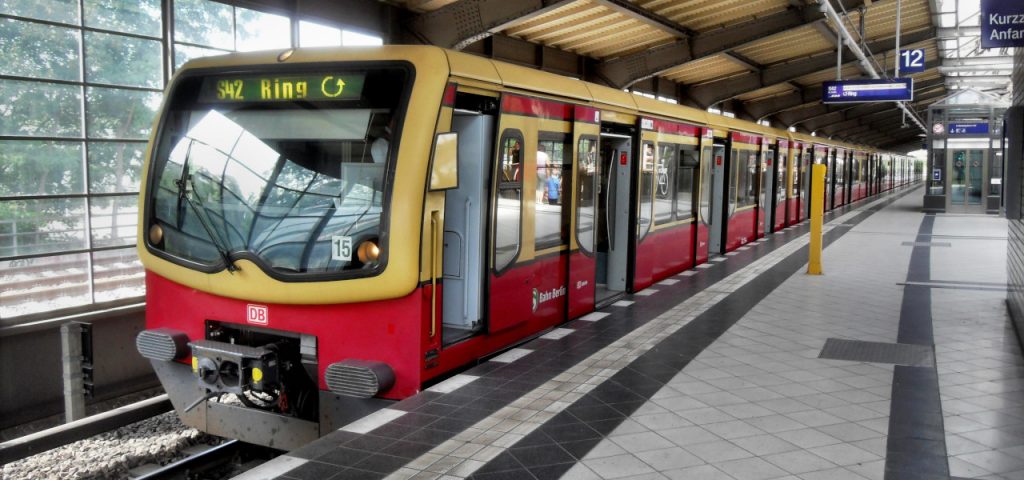
U-Bahn
U-Bahn or ‘Untergrundbahn’ in German translates to ‘underground railway.’ They are slower than the S-Bahn trains, but stop more frequently and have many more routes. Despite their name, some do travel above ground. U-Bahn stations are labelled with a giant blue ‘U’ and easy to find.
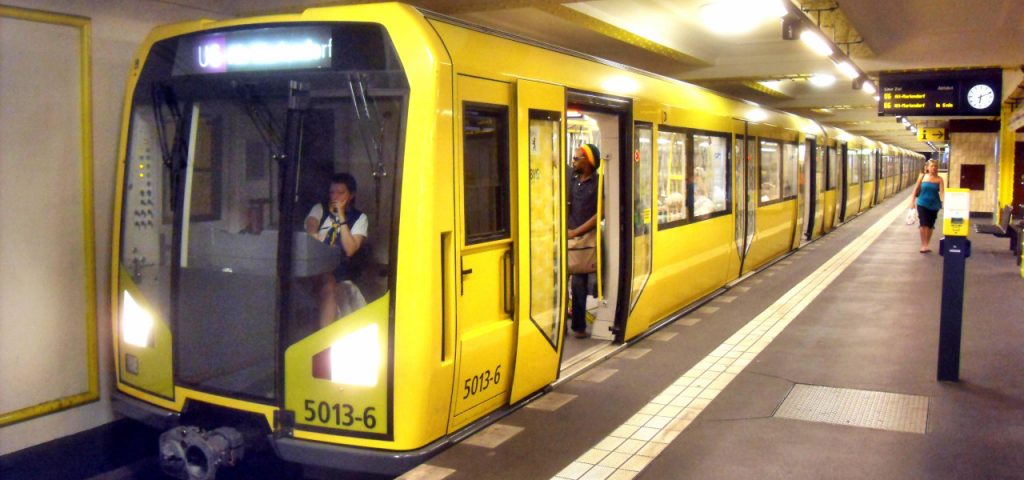
Trams
For historical reasons, trams are far more common in eastern Berlin. The tram system is much slower than the U-Bahn and S-Bahn, but go to many places that train systems do not serve.
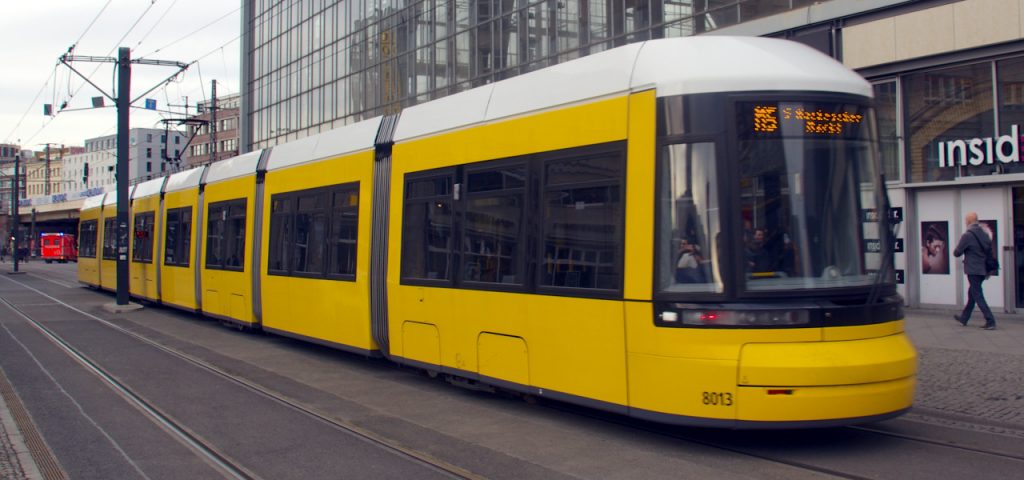
Buses
Berlin has an extensive bus service. There are more buses in western Berlin. It is common for buses to be used in place of other transportation methods if a train or tram is unable to operate. When boarding a bus, enter from the front and show the driver your (digital or physical) ticket as you go past.
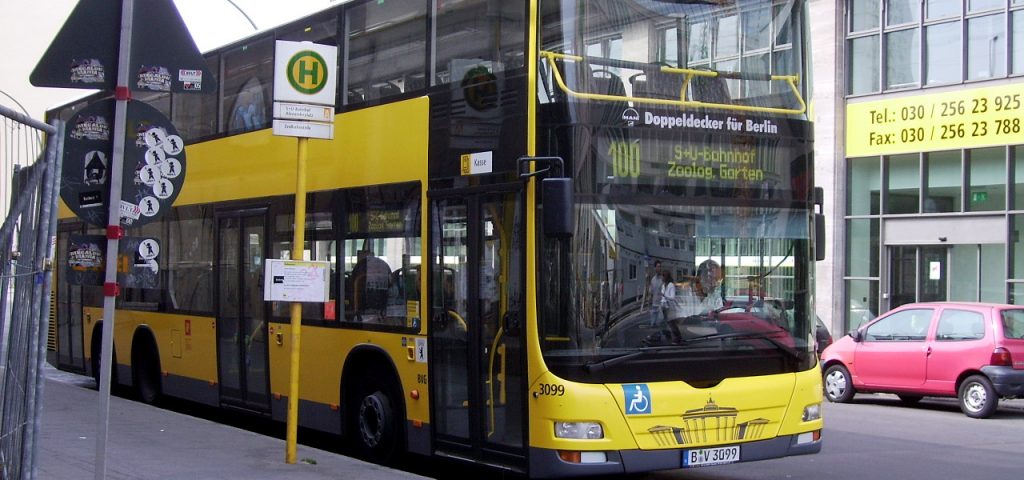
Accessible travel
The majority of the Berlin trains, trams, and stations are accessible via elevators or ramps, but not all. All Berlin buses are wheelchair accessible.
Detailed information on wheelchair accessibility for the Berlin public transport system can be found at wheelchairtravel.org/berlin/public-transportation. Visitors can also download the accessBerlin app.
Cycling
Berlin has an extensive cycle path infrastructure, making cycling an ideal way to get around Berlin. Many mapping apps such as Google Maps provide a cycle route service, which will normally suggest routes involving cycle lanes for you to travel on.
Bike sharing services are very popular in Berlin. These cheap rental bikes are scattered about the inner city, including around the WCEU conference venue. They can be located via their corresponding mobile phone app and unlocked for a small fee through their app.
The most common shared bike found in Berlin is Mobike, a Chinese company with distinctive orange and silver bikes. These bikes are the cheapest to rent, although their quality is often not as high as their more expensive competitors. The cost is €0.50 to €1.00 for 20 mins (cost depends on how new the bike is). They also have a flat rate monthly fee of €7.90 to ride as often as you want.
Another popular shared bike service is Lime, a USA based company with distinctive green coloured bikes. These are more expensive to ride than Mobikes, but are often of higher quality. Unlike other services, Lime also offers an electric assisted option too. The cost for Lime Bike rental is €1.00 for 30 mins, or €1.00 plus €0.15 per minute for an electrically assisted bike.
A new service called Jump was launched in Berlin recently by Uber. Their bikes are electric assisted and can be unlocked for €1.00 plus an extra €0.10 per minute of use.
Other bike sharing options include Donkey Bike, Next Bike and Lidl Bike.
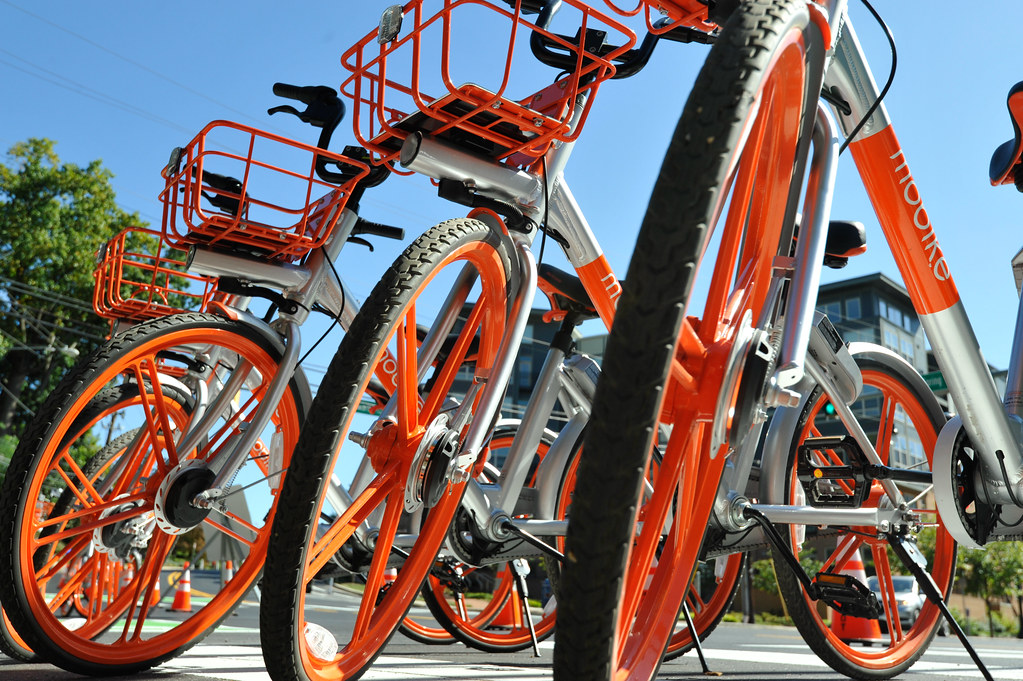
Ride sharing apps
Berlin is well serviced by taxis and ride sharing services. Uber was recently introduced and has become a popular way for tourists to get around the city. The most popular car service used by locals in Berlin, is the MyTaxi app. Note that the MyTaxi app calls a regular taxi, and in order to pay via the app, requires a data connection when you reach your destination. A newer ride sharing service available in Berlin, is the BerlKönig ride sharing service, which is provided by the local mass transit company BVG. Lyft is not available in Germany yet.
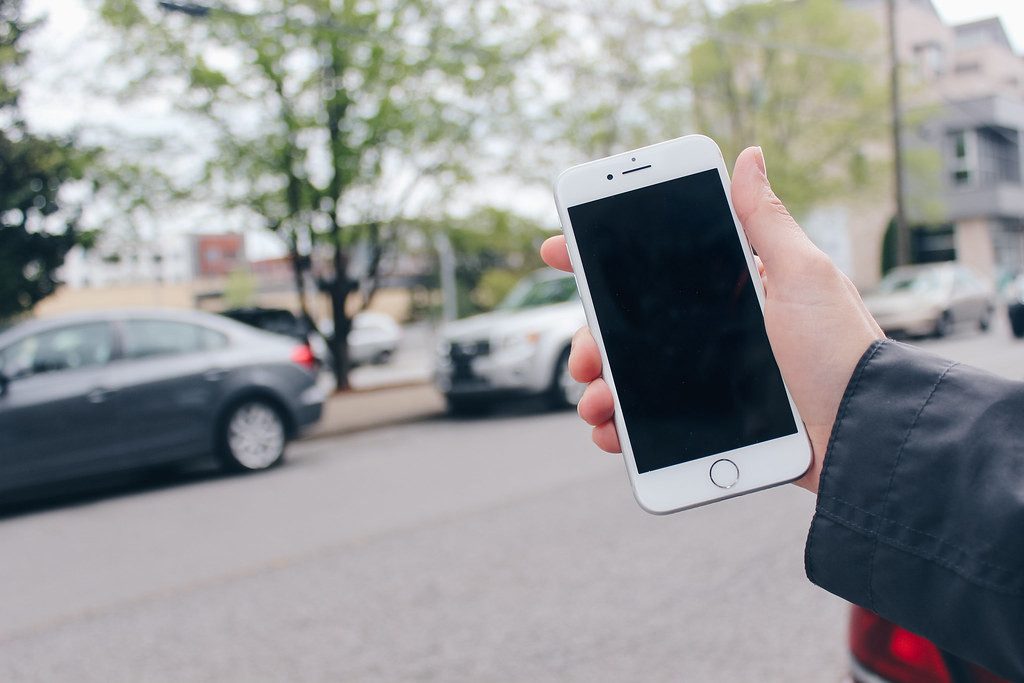
Taxis
All Taxis in Berlin are cream/ivory in color and have a yellow and black “TAXI” sign on the roof. Most taxis accept debit and credit card, but it’s best to check before starting your ride. Taxis in Berlin are licensed, metered, and the fares are regulated so there is no benefit in shopping around for a better price.
There are taxi stands located around the city, including outside Estrel, the WCEU conference venue. You can also find taxis parked on the streets and order them via taxi apps.
The most popular app used by locals in Berlin for calling a taxi, is the MyTaxi app. This app is multilingual and allows you to pre-schedule a ride and estimate costs. Paying via the app itself, requires a data connection when you reach your destination.
The Uber app can also be used for requesting a tradtiional taxi. Simply select the “Taxi” option instead of the “UberX” option when ordering your ride. Unlike the MyTaxi app, the Uber app does not require a data connection when you reach your destination.
